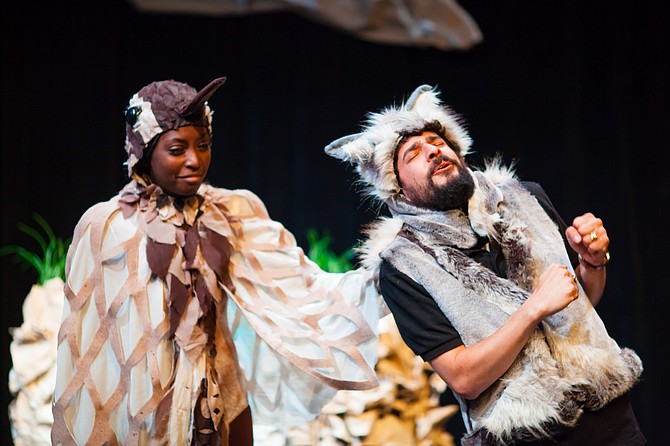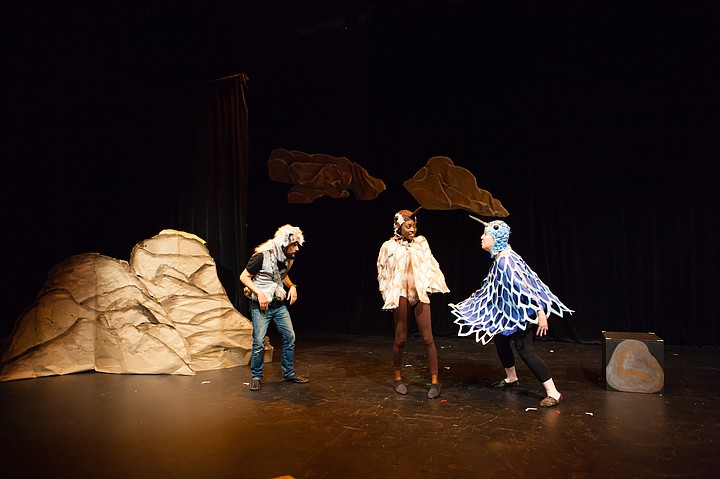 Facebook
Facebook
 X
X
 Instagram
Instagram
 TikTok
TikTok
 Youtube
Youtube

The latest offering from Circle Circle dot dot peeks into the world of San Diego's coastal habitat and the Sisyphean struggles conservationists face when industry moves in.
We meet doctoral student Ed Leopold (Michael Nieto) in the 1990s during his failed attempt to get the cactus wren on the Endangered Species List. The overhead projection of hand-drawn infographics he uses to make his case are a nice touch, firmly planting the scene in the not-so-distant past, as is his flannel shirt.
The storylines of Ed and a local cactus wren (Alexandra Slade) collide years later when the older and flannel-less scientist is tasked to survey land for the development of a new children's hospital. While Wren embarks on an adventure to find her family a new home after theirs is threatened by climate change, Ed engages in an uphill battle to please hospital liaison Natalie (Katherine Haroff) and find a piece of land that won't undercut his life's work.

The parallel conflicts set up a promising plot, though the execution suffers, at times, to address the all-important question: "Why should I care?"
The performances are engaging, though often weighed down by heady dialogue. Tuazon-Martin is hilarious as Coyote, a young pup in search of the perfect meal. The set, costumes, and props are simple yet beautiful. The most stunning piece, the Torrey Pine (Soroya Rowley) effectively uses stilts and fabric to illustrate the tree’s majesty. Likewise, Rowley brings Commander Gray, a gray whale, to life with elegant puppetry, proving it doesn't take much more than a little imagination and a few yards of fabric to create a world worth knowing. So, when the occasional obtuse dialogue dominates a scene and stifles emotion, the teacher in me yearned for more showing, less telling.
Anne Gehman’s choreography brought the "roller river" to life, using dance to illustrate the chaos of rush hour traffic and beautifully showcase obstacles facing Coyote and Wren. The rubber-helmet wigs, worn by the local news anchors (Veronica Burgess and Tuazon-Martin), played-up the cartoonish talking heads that dominate media today. The energetic prancing of the fairy shrimp (puppeted by Rowley and Burgess) was equal parts amusing and poignant.
Less explanation and more "showing" of Ed's personal and professional conflicts would be a nice balance to a production otherwise peppered with stylized performances that amuse through caricature and inform through creativity. When Ed finally meets Wren at the end of the play, their two worlds should dovetail in resolution, yet dialogue weighs down the performance once again, leaving the energy on stage flat.


The latest offering from Circle Circle dot dot peeks into the world of San Diego's coastal habitat and the Sisyphean struggles conservationists face when industry moves in.
We meet doctoral student Ed Leopold (Michael Nieto) in the 1990s during his failed attempt to get the cactus wren on the Endangered Species List. The overhead projection of hand-drawn infographics he uses to make his case are a nice touch, firmly planting the scene in the not-so-distant past, as is his flannel shirt.
The storylines of Ed and a local cactus wren (Alexandra Slade) collide years later when the older and flannel-less scientist is tasked to survey land for the development of a new children's hospital. While Wren embarks on an adventure to find her family a new home after theirs is threatened by climate change, Ed engages in an uphill battle to please hospital liaison Natalie (Katherine Haroff) and find a piece of land that won't undercut his life's work.

The parallel conflicts set up a promising plot, though the execution suffers, at times, to address the all-important question: "Why should I care?"
The performances are engaging, though often weighed down by heady dialogue. Tuazon-Martin is hilarious as Coyote, a young pup in search of the perfect meal. The set, costumes, and props are simple yet beautiful. The most stunning piece, the Torrey Pine (Soroya Rowley) effectively uses stilts and fabric to illustrate the tree’s majesty. Likewise, Rowley brings Commander Gray, a gray whale, to life with elegant puppetry, proving it doesn't take much more than a little imagination and a few yards of fabric to create a world worth knowing. So, when the occasional obtuse dialogue dominates a scene and stifles emotion, the teacher in me yearned for more showing, less telling.
Anne Gehman’s choreography brought the "roller river" to life, using dance to illustrate the chaos of rush hour traffic and beautifully showcase obstacles facing Coyote and Wren. The rubber-helmet wigs, worn by the local news anchors (Veronica Burgess and Tuazon-Martin), played-up the cartoonish talking heads that dominate media today. The energetic prancing of the fairy shrimp (puppeted by Rowley and Burgess) was equal parts amusing and poignant.
Less explanation and more "showing" of Ed's personal and professional conflicts would be a nice balance to a production otherwise peppered with stylized performances that amuse through caricature and inform through creativity. When Ed finally meets Wren at the end of the play, their two worlds should dovetail in resolution, yet dialogue weighs down the performance once again, leaving the energy on stage flat.
Comments